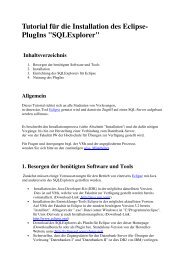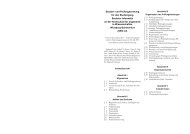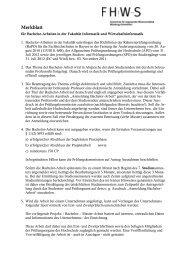FHWS Science Journal - Fakultät Informatik und Wirtschaftsinformatik
FHWS Science Journal - Fakultät Informatik und Wirtschaftsinformatik
FHWS Science Journal - Fakultät Informatik und Wirtschaftsinformatik
You also want an ePaper? Increase the reach of your titles
YUMPU automatically turns print PDFs into web optimized ePapers that Google loves.
Tobias Gegner<br />
approach leads to Boards and Parts, independent function units. These function units work<br />
without knowledge of their environment and are therefore independent. In FD diagrams function<br />
units are connected via data flows which represent the communication between different Boards<br />
and Parts. At that point the function units are composable, at least in terms of FD diagrams. EBC<br />
describe how to translate FD in object-oriented code, so that the implemented function units and<br />
components are composable and independent as well.<br />
2.3.1 How to Apply Event-Based Components<br />
The basic rules of translating Flow-Design diagrams into runnable object-oriented code are:<br />
• Every function unit, whether Board or Part, becomes a class.<br />
• Every input flow becomes an event-handler method of a class.<br />
• Every output flow becomes an event-sender method of a class.<br />
Following these rules, translating FD diagrams into code is pretty much straight forward.<br />
Though the connections between independent Parts have to be created. As well as the<br />
assembling of Parts to Boards needs to be solved. To achieve this and preserve the flexibility of<br />
FD, best practices and design patterns are applied. For readability of coding, it is helpful to prefix<br />
methods for input and output pins accordingly with ‘in ’ and ‘out ’ [Westphal, 2010c].<br />
2.3.2 Issues of Component-Based Software Engineering<br />
If we take a look at Component-Based Software Engineering [Heineman and Councill, 2001] we<br />
see that composing different components can be achieved through extracting interfaces from<br />
components. The extracted interfaces represent the service contract for the implementing<br />
component. Therefore the client components are independent from a concrete implementation of<br />
the service interface. Breaking with static dependencies from interface implementations at<br />
compile time can be accomplished by making use of the Dependency Injection design pattern<br />
[Fowler, 2004]. Thus client components can be bo<strong>und</strong> dynamically at runtime to a concrete<br />
service interface implementation. Hereby the client component gets more independent of its<br />
environment because it neither has to have knowledge of the implementation of the service<br />
interface nor it has to be able to instantiate a concrete implementation of the service interface. Yet<br />
a client component is still dependent of the service interface it makes use of. Since interfaces<br />
often define more than only one single method and may change over time the Single<br />
Responsibility Principle is broken. A client component would not only have to change if the<br />
signature of a used method of the interface changes but also if the interface gets decomposed<br />
into smaller distinct interfaces. Here the topological dependency of components from their<br />
environment shows up. Ralf Westphal named these components Injection-Based Components<br />
(IBC) due to the fact, that IBC are injected as whole component. This already points to where<br />
EBC are going. EBC resolve topological dependencies and leave components with functional<br />
dependencies only, which are uncritical and integral part of client-server relationships [Westphal,<br />
2010e, Westphal, 2010a].<br />
2.3.3 Connecting Function Units with Event-Based Components<br />
Event-Based Components connect different components by using events and event-handlers. A<br />
client component that needs a certain service fires an event. A subscribed event-handler of a<br />
<strong>FHWS</strong> SCIENCE JOURNAL, Vol. 1, No. 1, 2013 65








